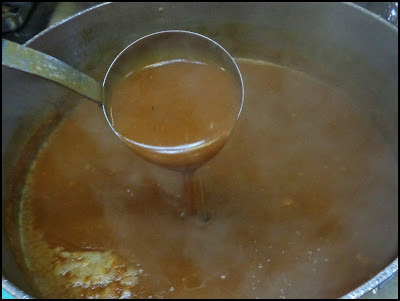Gravy Deconstructed...
The following text was originally published in Artvoice; to see it at its original location, click here.
Gravy
(grā’vē) n.,
pl.
–vies
a. The juices that drip from cooking meat. b. A sauce made by
thickening and seasoning these juices.
--The
American Heritage Dictionary
It’s as ubiquitous at a Thanksgiving
feast as the turkey itself. Mashed potatoes would be nothing without
it, ditto for the stuffing. Sometimes it’s thin and sometimes it’s
thick but it’s always there. I’m of course speaking of gravy.
But what is it, really? If you think
about it, it’s simply meat juice that has been thickened. But while
this may be true it’s also nothing short of alchemy, for there are
as many insipid and flavorless gravies as there are delectable ones.
Gravy may be part of our historical
Puritan feast (though I do question if it were on the original
Thanksgiving menu), but its roots go back further. Gravy is a simple
sauce, to be sure, and French chefs were the first to codify sauce
making. This said, gravy is something of a first cousin to the
classic au jus (with juice), or jus lié
(bound or thickened juice), or even more specifically and in plain
English: the thickened juices that dripped from roasting meat.
The etymology of the word gravy also
points to the French. According to historian Harold McGee, in his
encyclopedic tome, On Food and Cooking, the word gravy comes from the
antiquated French word, grané, which later became gravé.
It’s easily apparent how this could come out sounding like gravy to
an anglophile. Mr. McGee goes on to stay that the n was most
likely changed to a v in a simple calligraphy error
when transcribing one manuscript to another by hand.
Ok, by now you’re probably thinking
enough with where it came from, just give me a recipe. The thing is,
like many dishes, there is no one recipe for gravy, only methods; it
really depends on your situation--but it’s still very simple to
make. The variables are whether there’s a lot of liquid after the
turkey is roasted or if the pan is dry, whether you’re making it
directly in the roasting pan or a saucepot, and if you plan to
thicken it with flour or cornstarch.
Speaking of starch, the preferred
method by most professionals is flour, and to do this the flour
should be cooked in fat (butter, oil, or turkey grease), lest it
leave a lingering starchy flavor to the gravy. And when you cook
flour and fat together you are really making a roux, which is
not only the foundation to most thickened soups and sauces, but is
also French in origin; the word roux is said to be derived from an
old variation of the French word rouge, meaning red, which no
doubt makes reference to the change of color that occurs when flour
is cooked.
At any rate, I’ll stop complicating
an uncomplicated recipe and offer three different methods for making
gravy. They are extremely simple and can be adapted to whatever type
of meat you happen to be roasting. When adding liquid to gravy I
recommend using broth not water. Professional cooks have homemade
stocks readily available, but in the home kitchen canned broth is
perfectly acceptable. Keep in mind that canned broth already contains
salt, even the low sodium variety.
Turkey Gravy #1: When the turkey
is finished roasting and only a small amount of liquid remains this
method works well. This is also the classic method.
Remove the turkey to a platter. Place
the roasting pan on the stove over medium heat and cook it until the
liquid evaporates. Pour off all but a couple tablespoons of fat. Add
a few tablespoons of flour and cook it for a few minutes, taking care
not to burn the flour. Then whisk in a cup or two of chicken broth
and scrape any browned bits from the bottom of the pan, which are
pure flavor. Simmer the gravy for a minute or two then strain it to
remove any lumps and brown specks.
Turkey Gravy #2: If there is a
large amount of liquid in the pan this is a better method to follow.
Remove the turkey to a platter. Pour
the fat and liquid into a pot or bowl. Using a spoon or ladle
transfer a few tablespoons of fat to a small sauce pot, remove the
rest of the fat from the liquid and discard it. Heat the sauce pot
over medium heat. Stir in an equal amount of flour and cook the
flour/fat mixture for a minute or two while stirring. Add the turkey
liquid to the sauce pot and bring to a simmer. Lower the heat and cook
the gravy for a few minutes, then strain it to remove any lumps.
Season with salt and pepper if necessary.
Gravy #3: This is the simplest
method, though the gravy will have a transparent sheen to it, rather
than the typical cloudy sauce-like appearance. With this method it
doesn’t matter whether there is a lot of liquid or a little.
Remove the turkey to a platter. If
there is a lot of liquid remaining in the pan, pour it into a
sauce pot and remove and discard the fat. If there is little or no fat
remaining in the pan add a couple cups of chicken broth and place it
over medium heat. Scrape any browned bits from the pan, then transfer
everything to a sauce pot; remove and discard the fat. Bring the
liquid to a simmer. Dissolve a few tablespoons of cornstarch in an
equal amount of cold water and add it to the simmering liquid. Bring
the gravy to a boil and simmer for a minute or two. Season it, if
necessary, and strain to remove any lumps or brown specks.

Comments